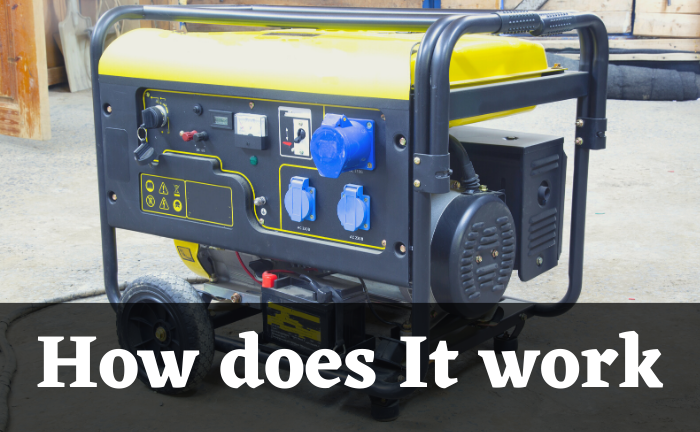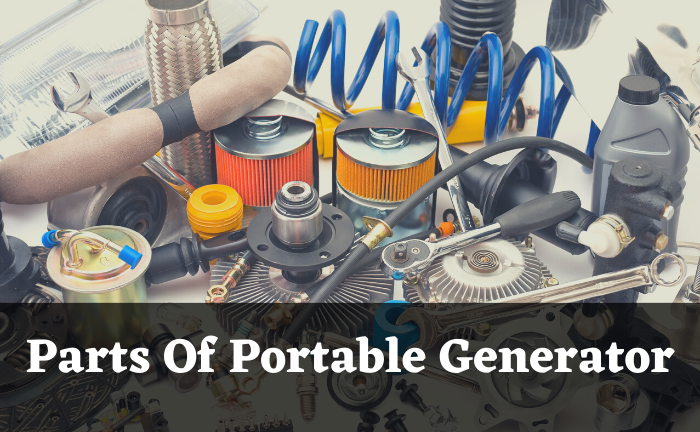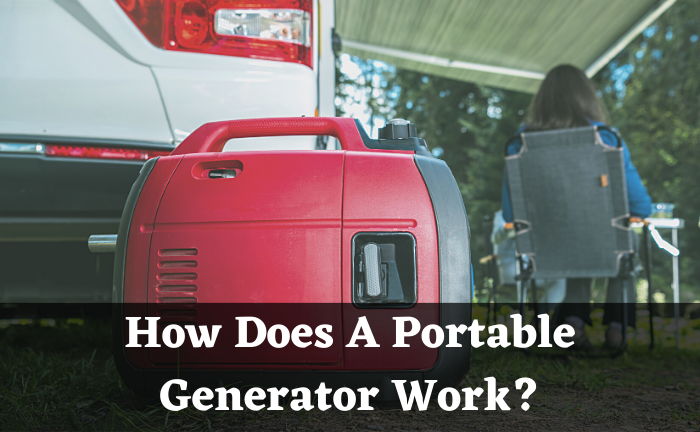A portable generator is a great source to prevent work disruption during power out. It turns mechanical energy into electrical energy and provides various outlets to power multiple appliances. With a tank full of fuel, you can use a portable generator for several hours. Similarly, unlike installed standby generators, portable generators are easy to move and ideal to use remotely.
If you’re wondering about the mechanism of a portable generator and want to learn how it works, then you’re at the right place. In this article, we’ll discuss a detailed guideline about the composition of a portable generator and how it works.
So without any further delay, let’s get straight into it.
Table of Contents
How does It work?

A portable generator might look like a complex unit at first glance, but its mechanism is quite easy to understand. You might wonder why a portable generator creates electricity, whereas it only converts mechanical energy into electrical energy due to electrical charges in the winding wire.
A generator’s fuel tank is filled with gasoline/fuel for ignition and is usually started with a switch or a cord. The moment it starts, the generator converts the fuel into electrical energy and runs the current through the wire on the principle of electromagnetic induction.
For better understanding, let’s break down the process in steps as follows
Stage-1 Fuel
The first step is to fill the fuel tank with the right fuel. Typically, diesel or petrol is used in generators; however, gas can also be taken in some cases. So first, you must top up the fuel tank carefully and use a funnel to avoid wastage.
Stage-2 Pull Cord
The next step is to start the portable generator by pulling the cord. However, the updated generators use switches as well. The moment you pull the cord, the fuel inside will transfer combustion energy as long as the tank is topped up.
Stage-3 Conversion Process
The next stage is the conversion process. When you ignite the engine, converting mechanical energy into electrical energy will begin using an alternator. A driving shaft attached to the engine, which spins an electromagnet within a coil to create and harness an electrical field, makes up the bulk of this alternator’s construction.
Stage-4 Current Regulation
Moving on further, the electricity generated is regulated among all the outlets and bodies of the generators. So a user can now easily connect the extensions and power up the appliances.
Parts Of Portable Generator

The electricity converted passes through various parts of generators, which have a huge role in the process. Moving on further, we’ll elaborate on all those parts and their functions.
Here are some of the important parts of a portable generator.
- Fuel System
- Engine
- Generator
- Circuit Breaker Switch
Fuel System
The fuel system is the first and most important part of portable generator steam. Your fuel system determines the longevity of your generator, so it is crucial to fill the correct petrol/diesel in it. Every portable generator has a different fuel system, so it is imperative to inspect it before operating it.
Make sure there is no clog in the pipelines preventing the fuel from reaching the engine. Check the user manual to learn about your generator correctly and top up it using the most suitable fuel. Usually, portable generators take petrol, diesel, and propane gas.
Engine
Here you’re going to discover about the workhorse of the generator, which is the engine. An engine is responsible for converting mechanical energy into electrical and takes petrol, diesel, or propane gas as a fuel. The mechanism of the engine is simple but interesting, and it is important to know how it operates. A portable generator’s engine is outfitted with various regulators.
Most standardized portable generator engines spin at 3600 rpm to provide a standard AC of 60 Hz. The engine also has a “governor,” which regulates the engine’s speed and rotations. The engine’s voltage regulator maintains a standard voltage of 120 volts.
Generator
The next on our list is the winding area called the generator. A generator comprises several regulators, including a stator, stationary coil, and rotor. It’s a centrally laminated coated metal winded by copper wires. It is responsible for converting the fuel from the engine into electrical energy that further creates a current in the cord.
A fan at one end of the generator is powered by a rotor bolt located in the center. This fan cools the generator’s other components.
Circuit Breaker Switch
To eliminate the excessive voltage from creating an explosion, a portable generator also consists of a circuit breaker switch. Sometimes while the generator is running and the power comes back, it could increase the flow voltage and explode the appliances connected to it.
Therefore, manufacturers install a circuit breaker switch as a safety measure to eliminate the risk of an explosion that could physically and financially harm you.
So these are the main components of a portable generator upon which the whole process is carried. We hope this would’ve proved helpful to you in understanding how the mechanism is operated.
Related: Are Honda Generators Worth The Money?
What To Look When Buying A Portable Generator For Camping?
Although the basic purpose of a portable generator is to supply power in a blackout, portable generators are also efficient for camping. If you want to purchase a portable generator for camping purposes, you have to evaluate what type of appliances you want to use on a campsite.
Hence, portable generators vary differently and sometimes become a little too noisy.
Due to noise limitations in place for the benefit of other visitors, larger, louder generators may not be permitted at some campgrounds.
As a result, it’s always a good idea to verify ahead of time with the proprietors of any campgrounds or caravan parks where you know you’ll want to take your portable generator and alter your buying plans appropriately.
What To Do If a Portable Generator Gets Overheating?
Sometimes portable generators get overheated due to excessive usage. Although it is normal sometimes things can go out of hand, if you face the same case, immediately check the user’s guide and see what it says.
Along with that, keep an eye on the following things,
- Fan consistency, rotation speed, and belt tension are all important considerations (for air-cooled versions)
- Excessive dirt or grease on the engine housing’s exterior
- Coolant levels and the operation of coolant loops/circulation (for liquid-cooled versions)
- Excessive or insufficient gasoline
- Clogged intake and exhaust zones (particularly fuel injectors and air filters/vents)
- Low quantities of oil
- Exhausts that are damaged or blocked
Related: How To Ground A Portable Generator?
Wrapping Up
Having a portable generator in times of power off is a blessing. It makes you do work uninterrupted for hours and similarly allows you to operate several appliances. However, learning about its mechanism is necessary if you have a portable generator.
In this article, we have included all the essential components and a brief guide to tell you how it works. In this way, if you ever face trouble with ins and outs, you’ll be able to do it yourself.
However, don’t take the risk if things feel complex and call for professional assistance immediately to handle the situation correctly.
Hope this article will prove helpful to you.

